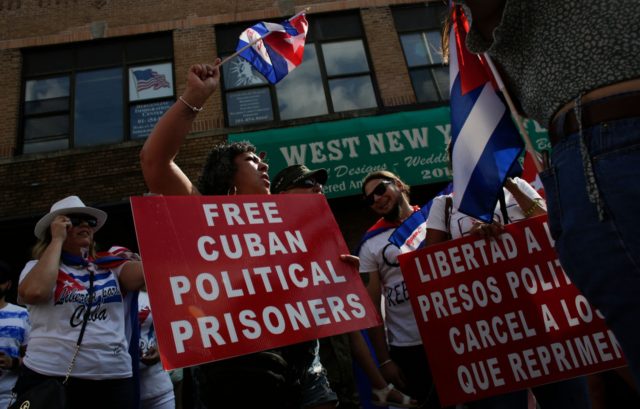The human rights organization Cuban Prisoners Defenders released a report on Thursday confirming the existence of 683 political prisoners in Cuba, a number representing a 400-percent increase from the number in November 2020.
Cuban Prisoners Defenders emphasized that the number is much smaller than the actual total of political prisoners in the country – it represents only the people who the organization could confirm were in police custody and had been convicted specifically due to expressing opinions contrary to communism.
The non-governmental organization (NGO) had documented 137 confirmed political prisoners a year ago this month, 398 percent fewer than those confirmed this week.
The communist Castro regime regularly detains and physically assaults known political dissidents, particularly those who lead underground anti-communist organizations or speak out publicly against the regime. To keep the number of political prisoners low, however, it does not convict most of these of any crime. Instead, police arrest them regularly, physically abuse them, and release them a day or two later, only to arrest them again shortly thereafter. Some dissidents, like Ladies in White organization leader Berta Soler, face beatings and arrest on a nearly weekly basis, but the regime never charges them with any crime.
The Castro regime publicly denies that it keeps prisoners of conscience despite the existence of dubious “crimes” on the books in Cuba such as “disrespect.”
Of the over 600 political prisoners that Cuban Prisoners Defenders documented, the organization classified 591 of them as “active” cases. Among these, 370 people, or about 63 percent, were arrested in incidents related to the nationwide protests that occurred on July 11. That day saw an estimated 187,000 people take the streets of every major city and town in the country to demand an end to the communist regime and respect for basic fundamental freedoms. In response, the Castro regime reacted violently, spending the next month executing paramilitary-style raids on the homes of suspected protesters and arresting people caught watching – not necessarily participating in – the protests.
Cuban Prisoners Defenders asserted that the list is likely a very small fraction of the true number of people imprisoned, many of which are simply missing, unacknowledged as prisoners by the government. Many others, in an attempt to keep the number of political prisoners low, are relegated to house arrest or other non-prison forms of restrictions on their freedom of movement.
The 370 cases related to the July protests, the organization stated, are “still less than 25% of the total generated by the repressive wave, as it is impossible to know the number of cases among the population.” The vast majority – 85 percent – of the cases related to July 11 were of individuals with no prior criminal record, indicating not only that they have no record of illicit activity, but that they have not been active in the anti-communist dissident community, whose members face routine arrests.
It added that Cuban state security agents arrested another 11,000 civilians “8,400 of them convicted and 2,538 sentenced, with average sentences of 2 years and 10 months in prison, for charges referred to in the Penal Code as ‘pre-criminal,’ i.e. without a crime.”
Cubans attempted to document as much of the repression following July 11 as they could with their mobile phones, though few images surfaced from the island in the days after due to a nationwide internet outage intended to disconnect protesters from the outside world. The few images that surfaced were jarring. In one video, police can be seen ripping people off of the street and arresting them without cause in Havana just in case they were planning to organize an anti-government assembly. In another, paramilitary “black beret” forces storm the home of a civilian in Cárdenas, Cuba, shooting him in his living room in front of his wife and two-year-old twins.
Human rights groups estimated that as many as 5,000 people disappeared, presumably into police custody, immediately after July 11.
The fate of the few prisoners charged with crimes and processed through the Cuban criminal justice system was often determined wholesale. According to a Cuban Prisoners Defenders report from late July, Cuban courts tried and convicted as many as 30 people at a time arrested in completely different situations.
“The summary ‘trials,’ with no lawyers or possible defense, are happening simultaneously in numbers of ten accused at a time, and we have even had knowledge of cases of 30 accused [processed] simultaneously,” the organization denounced. “We are talking about hundreds of people being processed, if not thousands. Extremely grave.”
A more extensive report published last month by Human Rights Watch accused the Castro regime of “brutal abuses” against protesters and those simply in the vicinity of a protest on July 11.
“When thousands of Cubans took to the streets in July, the Cuban government responded with a brutal strategy of repression designed to instill fear and suppress dissent,” Juan Pappier, senior Americas researcher at Human Rights Watch, said following the release of the report. “Peaceful protesters and other critics have been systematically detained, held incommunicado and abused in horrendous conditions, and subjected to sham trials following patterns that indicate these human rights violations are not the actions of rogue agents.”
Cubans have organized another mass nationwide protest for November 15.

COMMENTS
Please let us know if you're having issues with commenting.